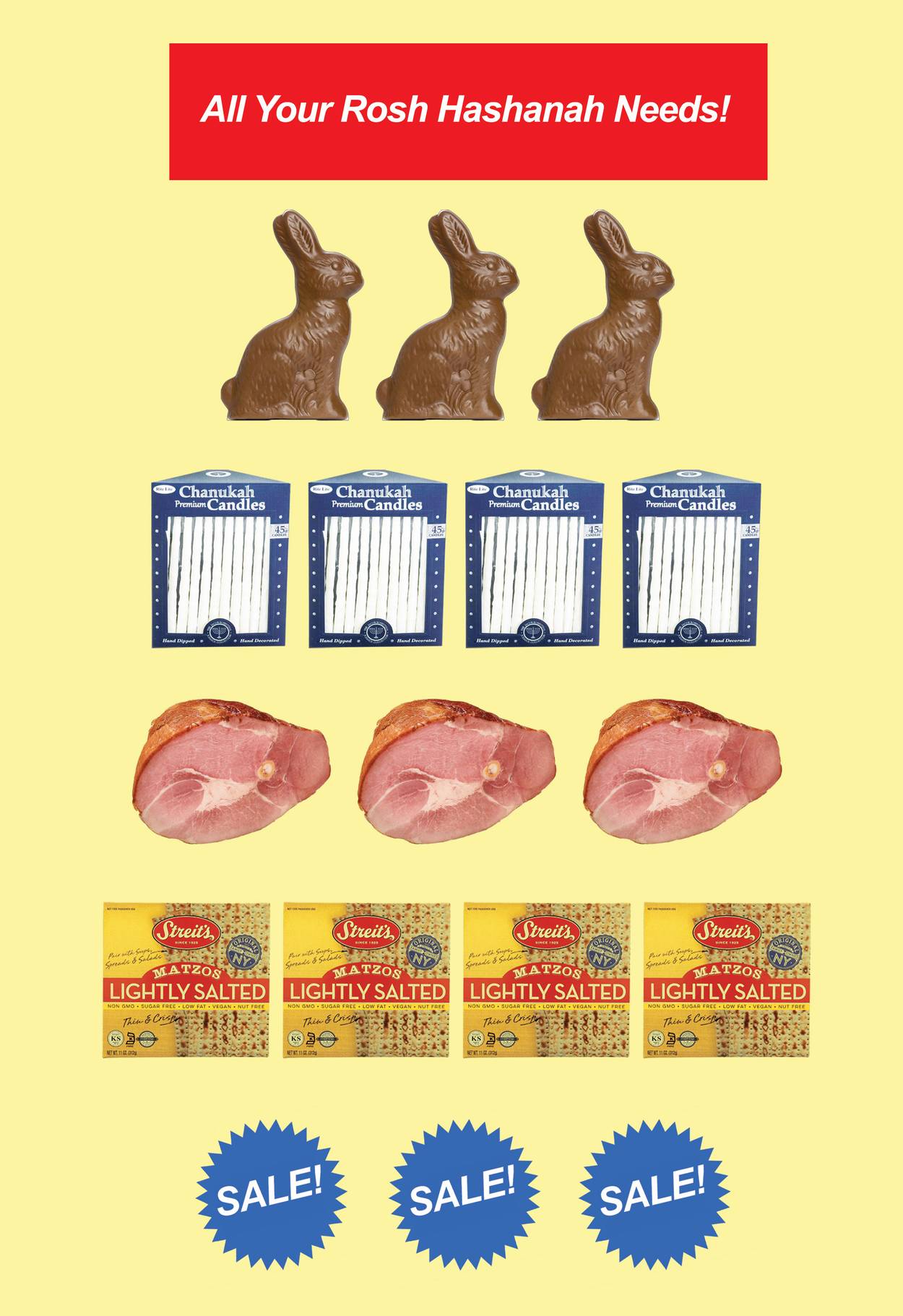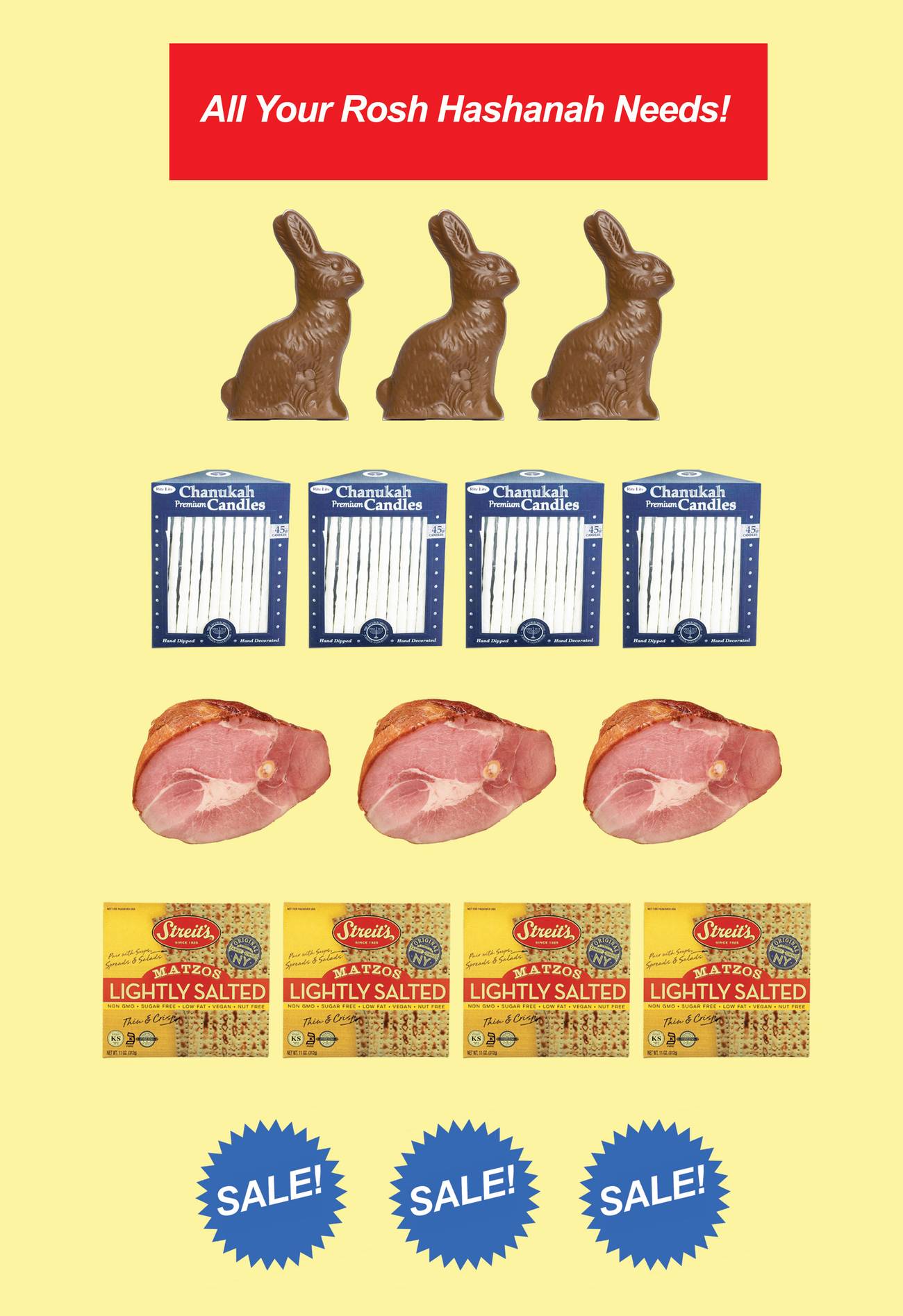Why Grocery Stores Get Jewish Holidays All Wrong
Matzo for Rosh Hashanah? Ham for Hanukkah? Challah for Passover?




Did you hear the one about the grocery store that was selling ham (yes, actual ham) for Hanukkah? How about the supermarket that constructed a pyramid’s worth of matzo boxes just before Rosh Hashanah, or the one that stocked hamantaschen next to the honey bears? Over the last decade, the arrival of the Jewish holidays has increasingly been heralded on social media (and traditional media, too) with a parade of anecdotes from customers encountering stores’ well-meaning attempts to offer holiday products that spectacularly miss the mark.
People’s reactions over finding yahrzeit candles on a Hanukkah display, or photos of challah announcing the Passover section range from amusement to profound annoyance. How difficult, these posts and articles ask, could it be for a supermarket to do a little research? A Christian shopper would never be subjected to the humiliation of finding a Cadbury Creme Egg display before Christmas, or packaged fruit cakes on Easter!
As it turns out, however, “getting it right” is harder than one might think. And while a photo of a grocery store marketing boneless smoked ham as ideal for a Jewish holiday is objectively startling, there is more to the story than just a meme. Behind the punchline is the rather remarkable fact that the holiday section is there at all.
If you walk into a typical grocery store in a town with any discernible Jewish population, you are likely to find a shelf or two dedicated to Ashkenazi comfort and ritual foods: things like matzo ball mix, egg noodles, bottled borscht, and kosher grape juice. These products are often squashed somewhere along the store’s vaguely defined “ethnic” food aisle, which houses Indian curry sauces, packaged soba noodles, and other products that are deemed outside “mainstream” American tastes.
“Today, grocery stores, as part of the civic square, are attentive to a wide variety of backgrounds, but that was not always the case,” said Jenna Weissman Joselit, a professor, author, and historian of Jewish American culture (as well as regular Tablet contributor) According to a recent New York Times article, the ethnic aisle was born in the mid-20th century with an express purpose: “to serve returning WWII soldiers who had tasted foods from countries like Italy, Germany, and Japan while abroad.” Some of the foods eventually found a home in different aisles (think: jarred marinara), but the section itself remained, creating a ghetto of otherness amid a vast terrain of white bread, mayonnaise, and corn flakes.
So how did Jewish products end up getting their slice of the ethnic aisle? In the sage words of Yogurt (the lovable Yoda-like creature from Mel Brooks’ classic parody film Spaceballs): “Merchandising! Merchandising!” In her book The Wonders of America: Reinventing Jewish Culture 1880-1950, Weissman Joselit writes how Jewish food items got a significant assist from marketing and advertising firms like the Joseph Jacobs Organization, which specialized (and a century later continues to specialize) on the Jewish market.
In the early and mid-20th century, these firms, she writes, “developed a series of broadcast and print campaigns uniquely designed to court the kosher consumer.” They also worked behind the scenes to convince manufacturers and grocers that, despite their relatively small numbers, Jews were an “important buying group,” and that the weeks preceding Jewish holidays were a “big buying period.” Their efforts led to a bevy of mainstream companies seeking out kosher certification (famously Coca-Cola, among many others). But they also helped products made by Jewish companies make their way onto the shelves.
During the same period, the Jewish food industry was on the rise, with companies like Manischewitz, Rokeach, and Gefen producing packaged Jewish convenience foods for second-generation immigrants who wanted the flavors of home, without the considerable effort. By the 1950s, jarred gefilte fish was on its way to becoming an iconic fixture of Jewish holiday meals. “Reassuring consumers that mass-produced gefilte fish was just as tasty and economical as the kind Mother used to make, Jewish manufacturers turned a steady profit from their traffic in fish,” Weissman Joselit writes.
As neighborhood greengrocers gave way to larger grocery stores and then supermarkets, Jewish products came along for the ride. These foods were marketed as not just ritually fit, but also superior to competitors in terms of hygiene. “Popular shibboleths such as quality, cleanliness, and sanitation, were routinely enlisted on the side of canned goods [and] packaged matzoh,” writes Weissman Joselit. In this way, Rokeach’s bottled schav and Manischewitz’s packaged egg barley fit right in with the supermarket’s wide, clean, well-lit aisles—despite being arguably niche.
Finding overtly Jewish products in their local grocery store was a convenience to Jewish shoppers, and also a source of great pride. “Stores were offering up room on the shelf, quite literally,” Weissman Joselit said. “There was a sense of acceptance seeing these foods in one of the most basic public squares.”
Today, most Jews take it as a matter of fact that the kosher aisle exists for whenever the taste for kasha varnishkes strikes and that, in the weeks leading up to Passover or Rosh Hashanah, their local Whole Foods or Costco will ramp up the matzo or honey cake offerings. For Jews who are less keyed into the yearly holiday calendar, store displays can also serve as a reminder that the holidays are coming and it’s time to grab some Streit’s potato pancake mix. “In a way, for less ritually aware Jews, the grocery store becomes a cultural authority in its way,” Weissman Joselit said.
And yet, it is that same sense of expectation that makes any potential gaffes—even those far less drastic than a Hanukkah ham—feel personal. Because at some level they are a reminder that, despite the incredible gains the Jewish community has made in America since our great-grandparents arrived, we are still regarded by larger society as outsiders. (Sephardi and Mizrahi Jews, meanwhile, are essentially nonexistent by grocery store standards.)
Grocery buyers today rely on a mix of kosher vendors, distributors, and specialty suppliers like UNFI (United Natural Foods Inc.) to guide them toward holiday items. Buyers are typically placing orders for multiple stores serving varying Jewish populations, and have to decide not only what products to stock, but how much of an item to send to a particular location. “Hannaford has 184 stores operating across five states, so there can be variability from store to store,” said Ericka Dodge, a communications manager for the supermarket chain. “Understanding this and monitoring it takes time.”
Stores with smaller Jewish populations tend to get just the basics. But according to Lisa Azevedo, who is a category analyst for the Stop & Shop supermarket chain (which has more than 400 stores), she is always on the lookout for new products to send to larger locations. “Last year we introduced dried seaweed for Passover, because it is a phenomenal seller year round,” she said. “We also have introduced certified almond flours, coconut oils, and other trending items.”
According to Azevedo, one of the biggest challenges with serving the Jewish market is the ever-shifting holiday calendar. She starts planning for holidays months in advance, but nothing can change the fact that this year, for example, Rosh Hashanah is so early it overlaps with Labor Day. “You still have people on summer vacation so the holidays aren’t even on their mind yet,” she said. “You just have to use your gut and make an educated guess about what to stock.”
Taking a step back for context, stocking the Jewish food aisle requires an intimate knowledge of multiple holidays, each with annually shifting timetables and hyperspecific laws, customs and food symbolism on top of the year-round kosher certification needs. Yes, it can be funny (or irksome) to be greeted by Star of David sugar cookies before Passover, or stumble across boxes of matzo stocked alongside a display of apples and honey. But even the mistakes point to the fact that supermarkets have decided that doing the legwork to have Jewish products on the shelves is worthwhile. We are part of the family—sometimes in a messy way—but a part of it all the same.